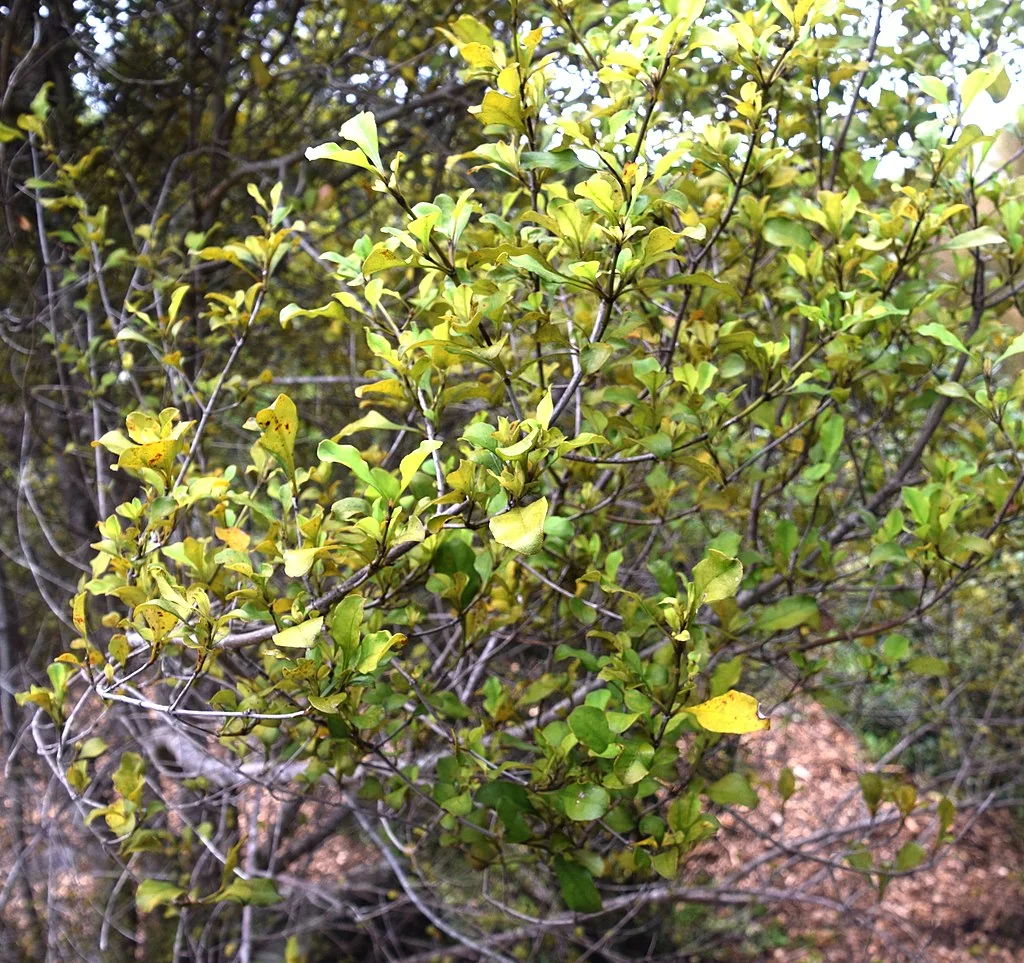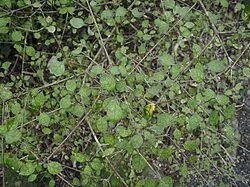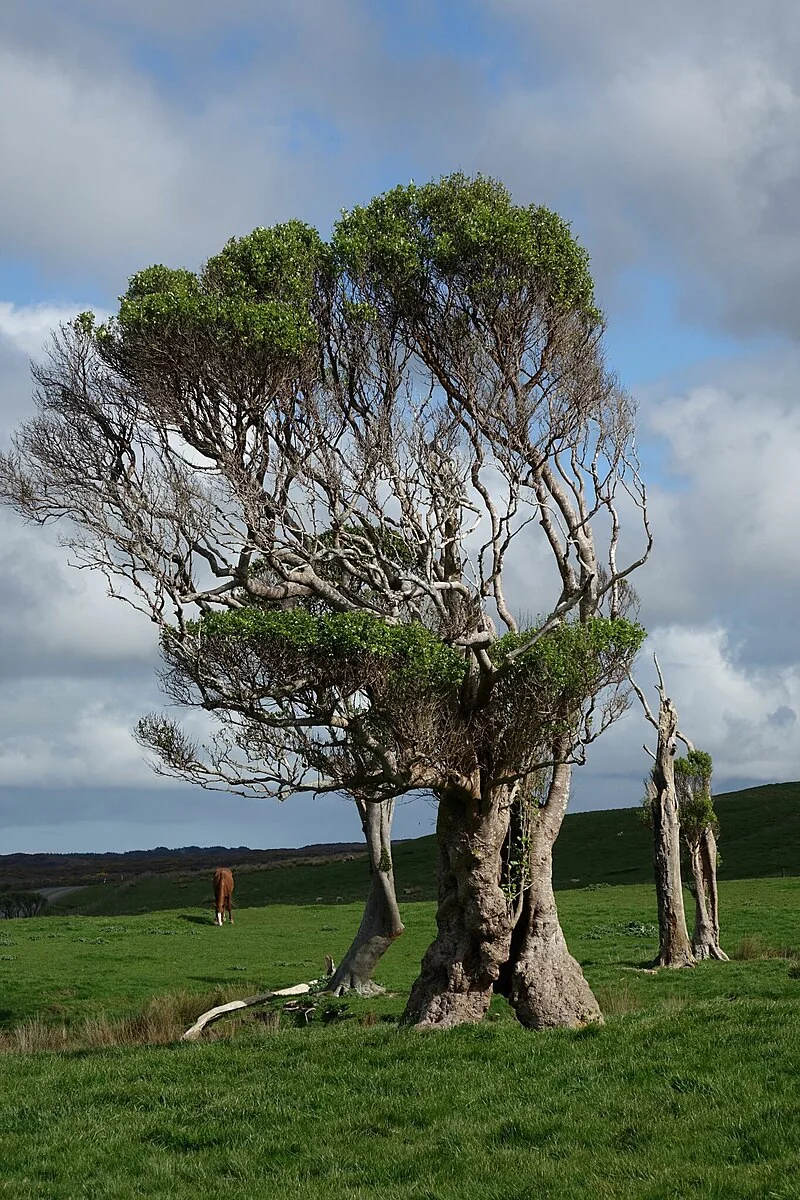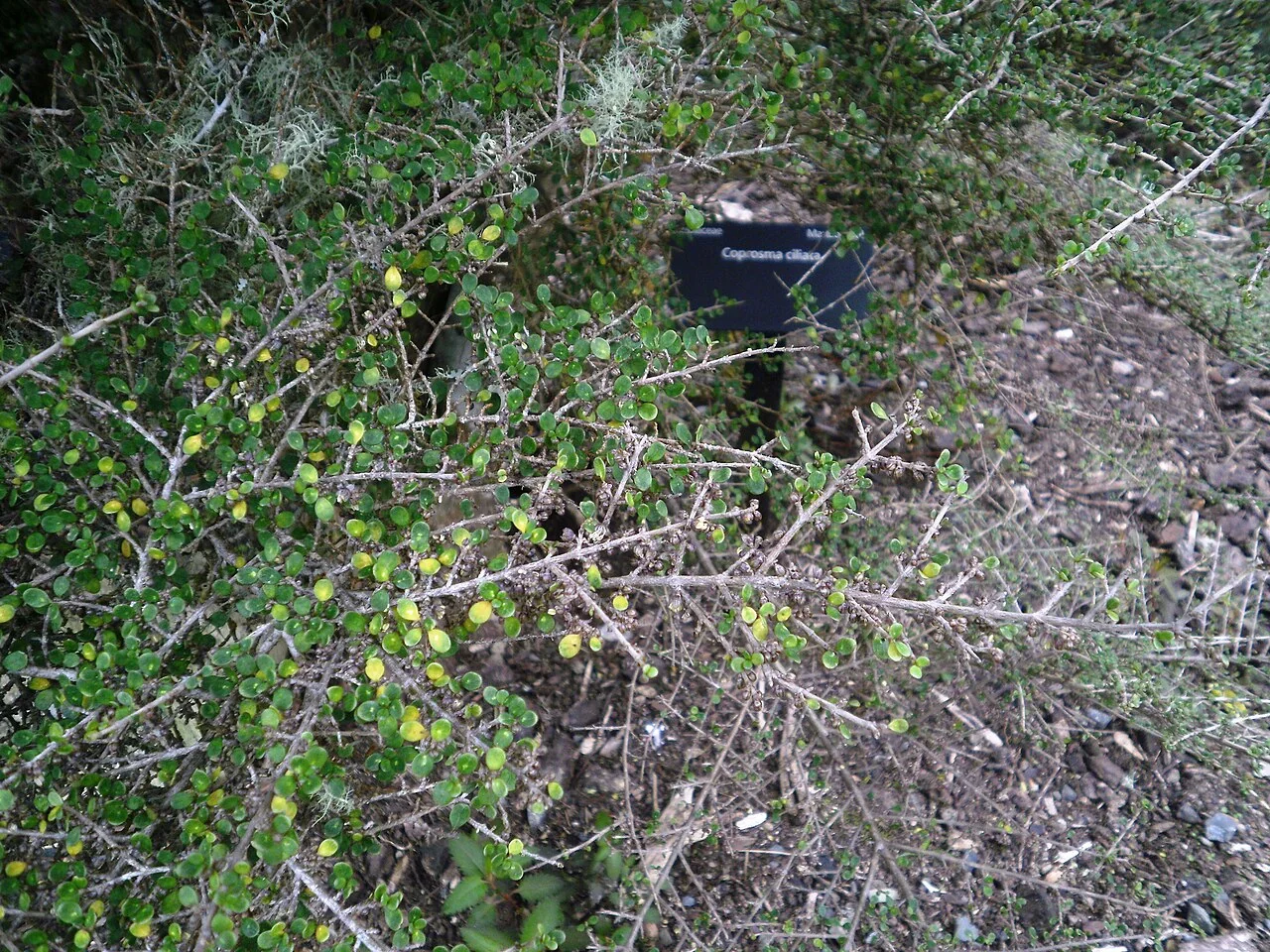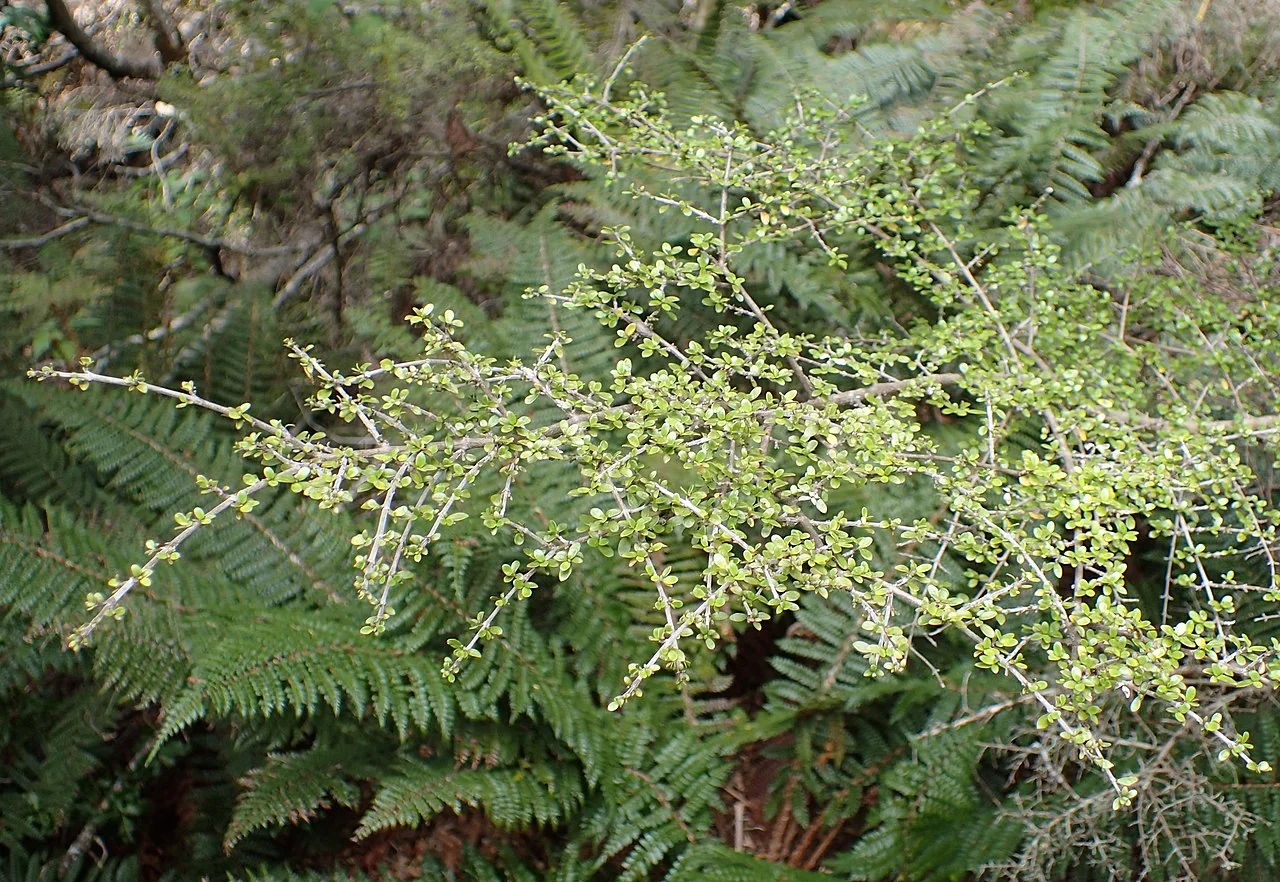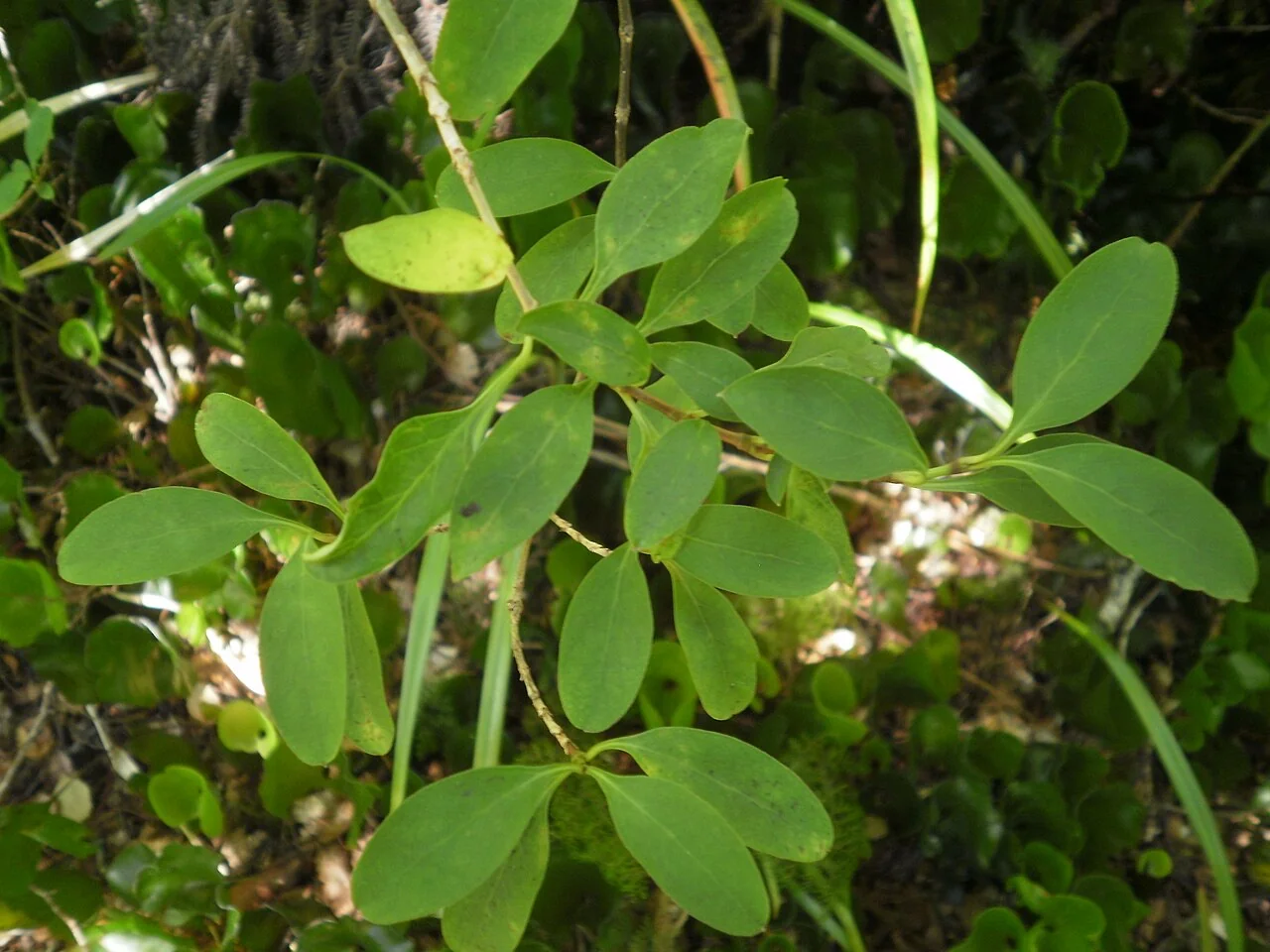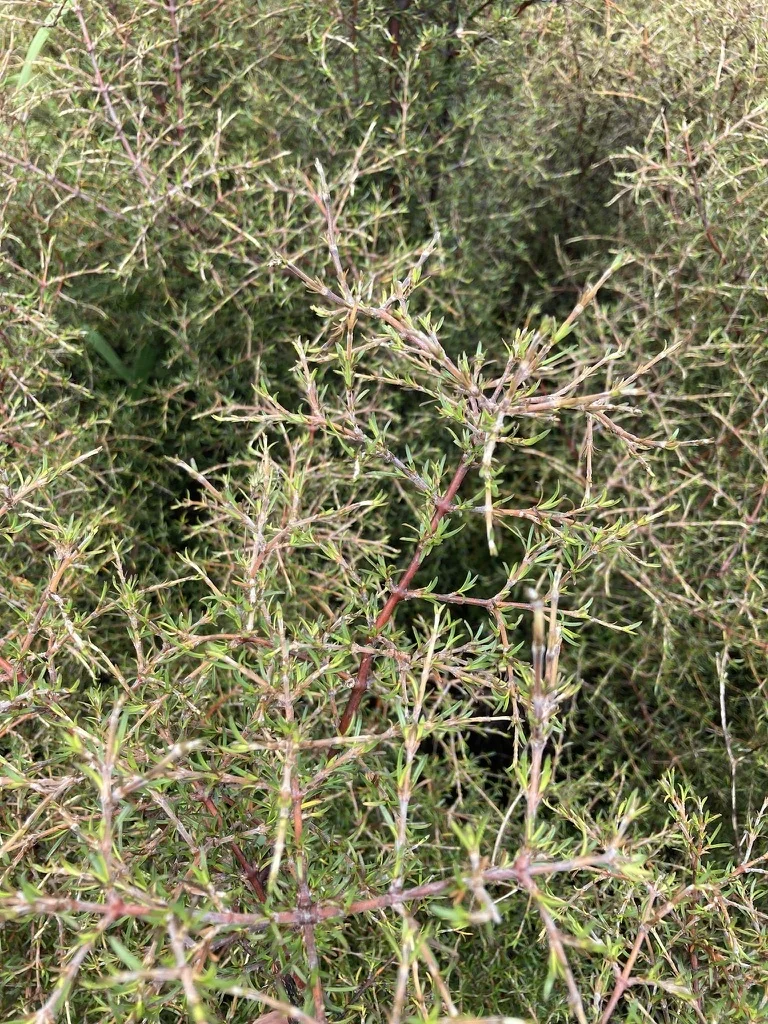
Mountain Coprosma
Coprosma rugosa
Needle-leaved Mountain Coprosma (scientific name: Coprosma rugosa ) is a distinctive alpine native shrub endemic to New Zealand, characterized by its needle-like leaves and extremely hardy mountain constitution. This tough native shrub grows in subalpine to alpine areas throughout both islands, forming dense, low-growing mats that can withstand harsh mountain conditions including snow, frost, and strong winds. The plant's narrow, pointed leaves give it a unique texture among New Zealand's mountain flora, while its small orange berries provide food for alpine birds. Its remarkable hardiness and distinctive appearance make it valuable for both ecological restoration in harsh environments and specialized alpine gardening.
Coprosma rugosa , also known as needle-leaved mountain coprosma, is an evergreen shrub native to New Zealand, belonging to the coffee family, Rubiaceae. It can grow up to 3 meters tall, with some varieties reaching 4 to 9 feet in height and 4 to 6 feet in width. This hardy shrub is characterized by its stiff, erect, and often divaricating (tangled, wide-angled) branches, which can display striking orange new growth. Its leaves are narrow, typically 10-14 mm long by up to 1.5 mm wide, and are clustered in pairs. The foliage can be green, or in some cultivars, bronze and chocolate-coloured. In spring, Coprosma rugosa produces inconspicuous green or yellow flowers. These are followed by small, pale blue or purple-white berries in autumn, which are a food source for birds and aid in seed dispersal. It thrives in various habitats, including lowland, montane, and subalpine grasslands, scrublands, and forest margins. The plant is known for its drought tolerance once established, as well as its ability to withstand frost and wind, making it suitable for exposed sites and arid gardens. Due to its dense growth, it is often used for hedging or shelter.

Plant Description
Botanical Features
Coprosma rugosa , commonly known as Mountain Coprosma or Needle-leaved Mountain Coprosma, is an evergreen shrub native to New Zealand. It is a very bushy, large shrub with many interlacing, wide-angled twigs that can grow up to 3 meters tall. Its leaves are tiny, narrow, and variable in shape, typically 10-14 mm long and up to 1.5 mm wide, often appearing in bundles. The foliage can range from dark green to russet tones of gold and brown, with new growth sometimes appearing orange. In mid-spring, it produces inconspicuous, small, pale cream flowers. Female plants bear small (3-4mm) purple-white berries, or drupes, in autumn, which ripen to a dark red or black colour. This hardy shrub is found in grasslands and forest margins, extending up to the subalpine zone, and is well-adapted to harsh mountain conditions including snow, frost, and strong winds.
Quick Facts
| Scientific Name | Coprosma Rugosa |
|---|---|
| Height | 0.3-1 m |
| Spread | 1-3 m |
| Water Needs | Low |
| Light | Full sun |
| Frost Tolerance | Excellent |
| Salt Tolerance | Poor |
| Growth Rate | Slow |
| Lifespan | Very long |
Climate Best Suited to
Needle-leaved Coprosma ( Coprosma rugosa ) prefers cool, moist conditions with good drainage and protection from extreme weather. It adapts well to typical New Zealand growing conditions with appropriate care and positioning.
Regional Suitability
| Whangārei | Ideal |
| Auckland | Ideal |
| Hamilton | Suitable |
| Rotorua | Suitable |
| Tauranga | Ideal |
| Gisborne | Ideal |
| New Plymouth | Ideal |
| Whanganui | Ideal |
| Palmerston North | Suitable |
| Napier | Ideal |
| Wellington | Ideal |
| Nelson | Ideal |
| Christchurch | Suitable |
| Dunedin | Suitable |
| Invercargill | Suitable |
| City | Climate Suitability |
|---|
Natural Habitat
Coprosma rugosa , commonly known as the needle-leaved mountain coprosma, is a hardy and widespread native of New Zealand, showcasing remarkable adaptability to a range of challenging environments. Its natural habitat extends from lowland areas to montane and even lower sub-alpine regions, where it is a common feature of grasslands, shrublands, and the margins of forests. It is particularly well-suited to open, exposed sites and is known for its ability to tolerate frost, drought, and high winds. This resilience allows it to form dense, interlacing thickets that can dominate the landscape in some areas. Its presence is a good indicator of a hardy ecosystem, and its tough, resilient nature makes it a key species in the regeneration of native bush in exposed and difficult sites.
Plant Conservation
Coprosma rugosa is currently classified as "Not Threatened" in its conservation status. This classification has been consistent in New Zealand since at least 2004, as reported and the Flora of New Zealand.
Growing Requirements
Soil Requirements
Needle-leaved Coprosma ( Coprosma rugosa ) performs best in well-draining soil that retains adequate moisture. Like most New Zealand natives, it prefers soils that don't become waterlogged but maintain consistent moisture levels. Good drainage is essential for healthy root development.
- Well-draining soil essential for healthy growth
- Prefers consistent moisture without waterlogging
- Adapts to various soil types with good drainage
- Benefits from organic matter incorporation
- Mulching helps retain moisture and suppress weeds
Light Requirements
Needle-leaved Coprosma ( Coprosma rugosa ) performs well in full sun to partial shade conditions. Like many New Zealand natives, it adapts to various light conditions but typically shows best growth and form in positions that receive adequate sunlight throughout the day.
- Full sun to partial shade positions
- At least 4-6 hours of direct sunlight daily
- Tolerates light shade in warmer climates
- Morning sun particularly beneficial
Water Requirements
Needle-leaved Coprosma ( Coprosma rugosa ) requires regular watering during establishment, typically for the first 1-2 years. Once established, it becomes more drought-tolerant but benefits from consistent moisture during dry periods. Avoid overwatering which can lead to root problems.
- Regular watering during establishment phase
- Moderate drought tolerance once established
- Consistent moisture during dry periods beneficial
- Avoid waterlogged conditions
- Mulching helps conserve soil moisture
Planting Guide
When to Plant
The ideal time to plant is during the vigorous growth period from late spring to mid-summer, or between May and June before the onset of summer heat.
Site Selection and Soil
- Sunlight: Thrives in full sun to partial shade. Brighter positions often lead to more intense foliage colour and compact growth.
- Exposure: Highly adaptable and performs well in exposed areas, including coastal conditions, windy sites, and even alpine environments where other plants might struggle.
- Soil: Well-drained soil is crucial, as it is prone to root rot in waterlogged conditions. It can tolerate a range of soil types, from sandy to loamy, and even clay-based soils if amended. Prefers neutral to slightly acidic soil.
Planting Steps
- Dig a planting hole twice as wide and to the same depth as the root-ball.
- Enrich the soil with organic plant food. If the soil is heavy or clay-based, add gypsum and fork it in well.
- Gently tease the roots and cut away any circled or tangled roots before positioning the plant in the hole.
- Backfill with soil, gently firming it down.
- Form a raised, doughnut-shaped ring of soil around the outer edge of the plant's root zone to help retain water.
- Water thoroughly immediately after planting to settle the soil.
After Planting Care
Water regularly and deeply during the first growing season to help the plant establish its root structure. Keep the soil moist for several weeks after planting. Once established (after about a year), it is drought-tolerant and requires very little watering. Avoid overwatering, especially in established plants, to prevent root rot. Occasional watering may be necessary during long, hot, and dry spells.
Ecological Role
Environmental Benefits
Coprosma rugosa , also known as Rugose Coprosma or Needle-leaved mountain coprosma, plays several important ecological roles, particularly in its native New Zealand.
- Food Source: Its small, inconspicuous greenish flowers are followed by bright orange to red or blue berries that are a valuable food source for native birds and insects.
- Habitat: The dense, bushy habit of Coprosma rugosa offers habitat for insects and provides dense cover for native birds.
- Restoration Plantings: Due to its hardiness and adaptability, it is commonly used in restoration plantings and shelterbelts. Its robust root structure makes it effective for erosion control on slopes and embankments. It is considered a suitable restoration species and a pioneer plant.
- Interlacing Thickets: It forms interlacing thickets in various habitats, including grasslands and forest margins, thriving in lowland to subalpine areas. This contributes to the structure and diversity of these ecosystems.
- Adaptability: Its adaptability to a range of conditions, including frost, drought, wind, salt spray, and pollution, highlights its resilience and ability to thrive in diverse and sometimes harsh environments.
Uses and Significance
Garden Uses
- Excellent for native plant gardens and restoration
- Suitable for naturalistic landscape designs
- Low maintenance once established
- Contributes to local biodiversity
- Attractive to beneficial native wildlife
Cultural Significance
Traditional Uses and Values
Coprosma rugosa , also known as Rugose Coprosma or Shiny Coprosma, holds cultural and ecological significance, particularly in its native New Zealand.
- Food Source: The non-poisonous, juicy berries, often bright orange, were historically eaten by Māori children. These berries are also a popular food source for native birds.
- Habitat and Biodiversity: It provides valuable food for native birds and habitat for insects. Its dense growth offers cover for small birds and insects.
- Restoration and Land Management: Coprosma rugosa is commonly used in restoration plantings and shelterbelts. It is suitable for erosion control due to its root structure, especially on slopes and embankments, and for biodiversity enhancement in upland areas. It is also used in riparian and pioneer plantings.
- Resilience and Adaptability: This evergreen shrub is robust, fast-growing, and tolerant of various conditions, including frost, drought, wind, salt spray, and pollution, making it a reliable choice for diverse garden and environmental conditions.
- Traditional Uses: The plant is harvested from the wild for local use as a food and source of materials.
Landscaping Uses
Garden Design Applications
Coprosma rugosa , also known as Rugose Coprosma or Mountain Coprosma, is a versatile and hardy evergreen shrub highly valued for its landscaping applications, particularly in New Zealand gardens. Its robust nature and dense growth habit make it suitable for a variety of uses.
- Hedging and Screening: It is an excellent choice for creating fast-growing privacy screens and windbreaks due to its dense, bushy habit and moderate to fast growth rate.
- Native and Wildlife Gardens: The shrub produces bright orange to red or small blue berries in autumn, which attract native birds, making it ideal for supporting local wildlife. Its dense foliage also provides cover for insects and birds.
- Erosion Control: Its root structure makes it effective for stabilizing slopes and embankments.
- Mixed Borders and Foundations: Coprosma rugosa adds texture and a glossy green colour to garden beds, integrating well into mixed plantings.
- Coastal and Urban Sites: This plant is tolerant of salt spray, wind, and pollution, making it a resilient option for exposed coastal areas and urban environments.
- Structural Planting: With its dense, upright, and spreading form, it can serve as a strong structural element in garden designs.
- Ecological and Revegetation Projects: It is commonly used in restoration plantings and shelterbelts due to its hardiness and adaptability.
- Mass Planting: Coprosma rugosa is well-suited for mass planting, creating a uniform and textured ground cover or larger display.
- Low Maintenance: Once established, it is drought-tolerant and requires minimal care, making it a low-maintenance option for gardeners.
Seasonal Care Calendar
Spring
Spring is an active growth period for Needle-leaved Coprosma ( Coprosma rugosa ). New growth emerges and this is an ideal time for planting new specimens. Monitor soil moisture as temperatures warm and growth accelerates.
- Active growth period with new foliage development
- Ideal time for planting new specimens
- Monitor soil moisture as temperatures rise
- Apply organic mulch if needed
Summer
Summer is typically the main growing season for Needle-leaved Coprosma ( Coprosma rugosa ). Ensure adequate watering during hot, dry periods, especially for young plants. Established plants show good heat tolerance with appropriate care.
- Peak growing season with active development
- Monitor watering needs during hot weather
- Young plants need consistent moisture
- Established plants show good heat tolerance
Autumn
During autumn, Needle-leaved Coprosma ( Coprosma rugosa ) begins to slow its growth as temperatures cool. This is another good time for planting as conditions become more favorable. Reduce watering frequency but maintain soil moisture.
- Growth slows as temperatures moderate
- Good time for planting new specimens
- Reduce watering frequency gradually
- Maintain soil moisture without overwatering
Winter
Winter is typically a dormant period for Needle-leaved Coprosma ( Coprosma rugosa ), with minimal growth activity. Reduce watering but ensure plants don't completely dry out. Most New Zealand natives are cold-hardy and require minimal winter protection.
- Dormant period with minimal growth activity
- Reduce watering but avoid complete drying
- Generally cold-hardy in most New Zealand climates
- Minimal winter protection required
When to Prune and How Much
Needle-leaved Coprosma ( Coprosma rugosa ) generally requires minimal pruning to maintain its natural form and health. Most maintenance involves removing dead or damaged growth and light shaping if needed.
- Remove dead, damaged, or diseased growth as needed
- Light pruning to maintain shape if desired
- Prune after flowering if applicable
- Avoid heavy pruning which can stress the plant
- Use clean, sharp tools to prevent disease
- Most natives maintain good form without regular pruning
Always use clean, sharp tools when pruning to minimize disease risk. Native plants typically maintain their natural form well and often require less intervention than exotic species.
How to Grow Mountain Coprosma
Mountain Coprosma is a remarkably hardy and versatile native shrub, well-suited to a variety of garden conditions, particularly those mimicking its natural alpine and subalpine habitats. Its dense, often colourful foliage and ability to withstand harsh weather make it an excellent choice for hedging, groundcover, or as a structural plant in native gardens. While it is a low-maintenance plant once established, understanding its propagation methods can help in expanding its presence in your garden or restoration projects.
From Cuttings
Propagating Mountain Coprosma from cuttings is a reliable and efficient method. Take semi-hardwood cuttings, about 4-6 inches long, from healthy, non-flowering shoots in late summer or autumn. Remove the leaves from the lower half of the cutting and, if desired, dip the cut end in a rooting hormone to encourage root development. Plant the cuttings into a well-draining cutting mix, such as a blend of perlite and peat or coarse sand. Keep the cuttings in a sheltered location with indirect light and ensure the medium remains consistently moist but not waterlogged. Rooting typically occurs within a few weeks to a few months. Once rooted, the new plants can be potted on and grown in a sheltered environment until they are ready for planting out.
From Seed
Growing Mountain Coprosma from fresh seed is also a viable option, though germination can sometimes be slow and erratic. Collect ripe berries in autumn, clean the seeds from the pulp, and sow them onto a tray of well-draining seed-raising mix. Lightly cover the seeds with a thin layer of fine grit or sand. The seeds benefit from a period of cold stratification, so placing the tray outdoors in a sheltered spot over winter can help break dormancy. Maintain consistent moisture in the seed tray, ensuring it never dries out completely. Germination can take several months, so patience is required. Once seedlings are large enough to handle, they can be pricked out and potted into individual containers to grow on.
Pests and Diseases
Coprosma rugosa , also known as Needle-leaved mountain coprosma, is generally considered a resilient plant, often described as pest-free and disease-resistant. However, it can occasionally be affected by certain pests and exhibit various symptoms that may indicate underlying issues.
Common Pests:
- Scale insects: Are among the most frequently mentioned pests for Coprosma rugosa .
- Other pests: That can affect Coprosma rugosa include spider mites, whiteflies, aphids, mealybugs, weevils, caterpillars, thrips, lace bugs, and leaf beetles.
- Eriophyid gall mites: Specifically the Coprosma white erineum mite, can induce white erineum (white hairs) on the underside of Coprosma leaves.
Common Diseases and Symptoms:
While specific diseases are not extensively listed, several symptoms can indicate problems with Coprosma rugosa :
- Leaf discoloration: Such as yellowing, yellow edges, or dark blotches. This can be a sign of inadequate lighting, nutrient deficiencies, or pest infestations.
- Brown or wilting leaves: May result from improper watering (either too much or too little), environmental stress, or nutrient imbalances.
- Leaf tip withering.
- Poor growth and stunted appearance: Can be caused by insufficient light, suboptimal soil quality, lack of essential nutrients, or pest infestations.
- Dodder, lichen, and moss: The plant may also be affected by these.
- Fungal infections: Regular pruning can help reduce the risk of fungal infections by improving air circulation.
Bonus Tip
Expert Growing Advice
Coprosma rugosa is a plant of contrasts. Its new growth can be a striking orange, while its berries can range from pale to dark blue, purple-white, or bright orange to red. This hardy shrub is so tough it can be found from lowland to subalpine areas and is tolerant of frost, drought, and wind. Its dense, tangled branches provide excellent shelter for native birds and insects.


